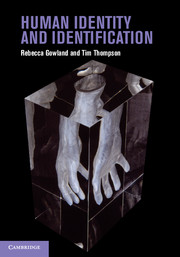2 - Categories of identity and identification
Published online by Cambridge University Press: 05 February 2013
Summary
[W]e should not be accepting our body as a given, as natural, as pre-discursive, or prior to culture. The body is not a foundation. It is not a biological bedrock upon which we can construct theories of gender, sexuality, race and disability.
(Cream, 1994: 2)The social descriptors of gender, age, ethnicity and class are pre-eminent in the human identification and identity literature. For the purposes of discourse and analysis, individual and group identity may be conveniently fractured into these four key categories, but in actuality these multiple dimensions act in concert so that, for example, the experience of gender within any one society will also depend on social class, ethnicity and life course stage. While dominant in Western scientific and social discourse, these categories are not meant to be an exhaustive taxonomic representation of human experience; in everyday life a whole spectrum of other identities will come into play (Meskell & Preucel, 2004). Categories serve to construct notions of sameness and difference, and these may or may not reflect the social reality. Categories have boundaries and at boundaries lie discontinuities and tensions. What complicates any analysis of this area is that any individual has access to multiple self-categorisations (Emler, 2005). Identity is also experienced relationally; it is not simply how we view ourselves, but how others perceive us, and thus is much more fluid than the boundedness implied by Western categorisations. Identity can be passively ascribed and experienced, but is often actively constructed and reinforced by both individual agency and society-specific social structures (Díaz-Andreu & Lucy, 2005). Despite these caveats, age, gender, ethnicity and class have profound resonance for how we identify ourselves and others and thus feature extensively in biological and social science research. It is the dialectical relationship between these different aspects of identity and the physical body that is of interest in this book. We seek to examine and discuss some of the multitude of ways in which these aspects of identity become literally embodied by different physiological tissues. We also seek to understand the ways in which our construction of these categories impacts our scientific analyses of the body.
- Type
- Chapter
- Information
- Human Identity and Identification , pp. 15 - 36Publisher: Cambridge University PressPrint publication year: 2013



